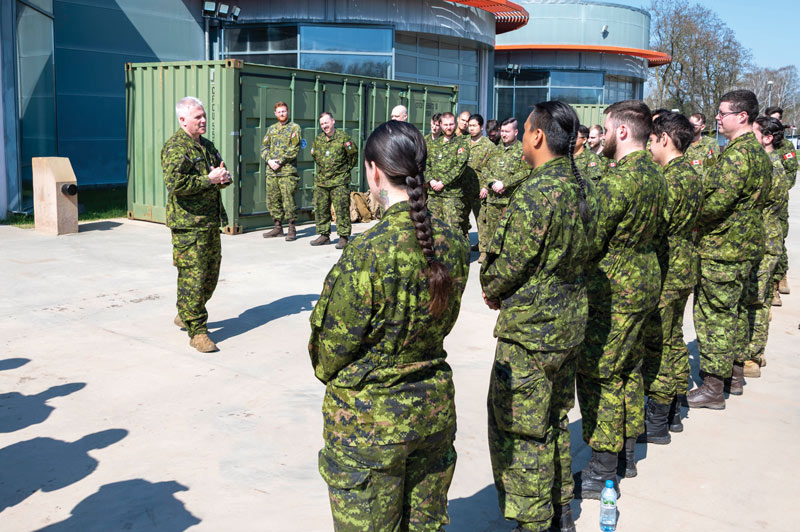
The recent troubles of the Canadian Armed Forces, especially the sexual misconduct committed by senior officers, have received significant and continuing media coverage. Stephen M. Saideman, an international relations and defence specialist at Carleton University in Ottawa, noted in The Globe and Mail last March that this contributed to the military’s morale problem “not because men have been punished for abusing their power and their subordinates—it’s because those men had been allowed to thrive, alienating others. An effective military is impossible if one distrusts one’s commanders.”
Saideman’s conclusion: “Changing the CAF’s culture is aimed at resolving this problem. It means promoting people who treat their subordinates decently, and on merit. It means holding everyone to higher standards. It means refusing to tolerate hate within the forces—getting rid of misogynists, homophobes, white supremacists and other haters—because war is a team sport, and one simply cannot have a good team if some members have contempt for the rest.”
All true, but Canada’s military culture is also shaped by other factors. The men and women of the forces are paid quite reasonably, but those posted in or near large cities cannot afford to buy or rent a house, and the families living on bases often live in substandard dwellings—if they can get them. The waiting lists are long, and the Defence Department, underfunded as it is, cannot get enough housing units built to meet the demand.
Nor, it seems, can National Defence Headquarters pay its soldiers’ bills on time. Consider the case of those stationed in Poland to train Ukrainian troops. DND decided not to dispatch cooks with the troops, a decision justified by the relatively small numbers deployed. Initially, Poland fed the Canadians, but when that ceased, Ottawa told the soldiers to eat at restaurants and submit their bills for reimbursement. That might have worked if the expenses were promptly repaid (and if the soldiers found Polish restaurants close by palatable and reasonably priced). But they weren’t, which meant that soldiers’ families struggled to cover their bills while waiting months for Ottawa to pay them back. Only when the families complained to the media did HQ commit to fast-tracking a solution. This was, and is, completely unacceptable.
Even more disheartening is the widespread sense among those in uniform that the CAF simply does not matter to the Canadian government. The defence budget is not even close to meeting Canada’s pledge to NATO to devote two per cent of gross domestic product to the military (it spent 1.32 per cent of GDP, about $24 billion, in fiscal 2021-22).
Meanwhile, the 2023 budget promised $13 billion over five years for dental care and $70 billion in subsidies to green energy corporations, leaving little reason for the army, navy and air force to hope for better days. In consequence, military equipment is increasingly obsolescent and new gear, long promised, is almost always delayed by a slow and ineffective procurement system.
Canada’s servicemen and women are competent and well-trained, but they are now simply ill-equipped to meet adversaries on the battlefield. No military culture, however robust, can withstand such a situation.
Not to fear, however. The Canadian Armed Forces devised new dress and deportment regulations in 2022 in part to address the recruiting challenges posed by the sexual misconduct scandals, slumping morale and a shortfall of 16,000 personnel.
What would appeal to the country’s young men and women? The answer, as laid down in the new CAF regulations, was that they “should reflect the changing norms in Canadian society. This will welcome a more diverse group of CAF members, which will benefit the CAF as diversity is a known force multiplier.”
Consider the new rule for hair: “Full or partial shaving of hair on the head is permitted. Colouring of hair is permitted. The wearing of wigs, locks, or hair extensions is permitted. Long hair is permitted but must be secured…in such a manner to prevent hair from falling in or covering the face when leaning forward.”
No military culture can withstand such a situation.
In other words, personnel can have any colour hair down to their shoulders when in uniform. In addition: “all styles of facial hair and sideburns are authorized. Facial hair may be braided/pony tail style and coloured.” At the same time, male and female “members may wear coloured nail polish, artificial nails, temporary lashes, and eyelash extensions.” In addition, men may wear skirts if they wish, so long as the hem falls below the knee.
If these new regulations worked to attract new and diverse recruits, they might be justified. Thus far, however, they have had no such effect. Recruitment continues to be slow while retirements increase. This is no surprise to those who have served (or somehow continue to serve).
The Canadian Forces, much like those of its allies, has largely attracted people who appreciate discipline and order, military traditions, appearance and uniforms, and want to master their trades—much more so than those concerned with the individuality inherent in hair styles and the like.
Morale is always difficult to create and maintain, and Saideman has correctly noted some of the factors that have weakened it. But the new dress regulations do nothing to address the problem. Indeed, they make it worse. The CAF has genuine problems—housing, equipment and a growing personnel shortfall—and these new rules won’t address those.
Somehow the defence minister, the defence chief and the committees at National Defence Headquarters that authorized these regulations have lost the plot. By all means, fight against sexual misconduct, discrimination against minority groups, and do more to keep radical ideologists out of the ranks. But do not make the CAF a laughingstock to the country’s population and the militaries of its allies. That, unfortunately, is precisely what the new dress regulations do.
Advertisement





















